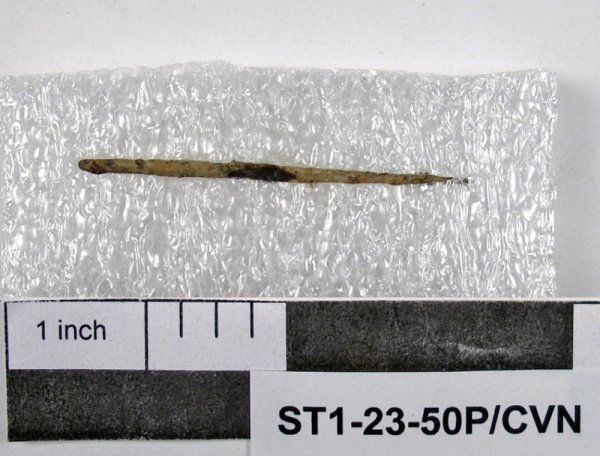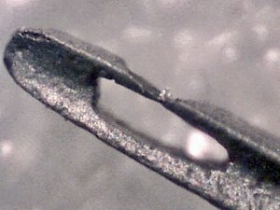Sewing Needle

Conservator’s Notes
Even the smallest objects that survive on archaeological sites can reveal the most interesting details. A very small, thin iron needle was recovered during excavation of the St. John’s Site. Its dimensions are no bigger than 3 inches long by 1/8 inches in diameter. The fact that this object survived in the ground is very rare, but it also survived almost 40 years out of the ground in storage. The object was discovered in a box of other artifacts from the St. John’s site with no special packaging or attention given to it. It looked like any other small iron object at the time. The details of the object were first discovered during an x-radiograph of the object. The eye of the needle was visible, and it seemed that the object was complete. Even though the object had survived both burial in the ground and storage afterwards, it is often very difficult to ensure the successful conservation treatment of such tiny pieces of metal.
In order to clean the object of obscuring corrosion products, some weight must be applied to the object to mechanically remove the layers of corrosion which had built up over time. It was decided for this object that it would be mounted in polyethylene foam for cleaning [Before treatment photo above] so that when pressure was applied during cleaning, the weight would be transferred to the foam behind the object. The corrosion on the object was carefully removed bit by bit to reveal details in the metal surface beneath. The iron object was so well preserved, in fact, the metal almost appeared silver, the original color of the iron when it was manufactured. The eye of the needle was completely intact as were thread groves and lines in the body of the needle. Digital photographs were taken under a microscope in order to view the details of the metal under magnification. Only a few very minor pits are visible in the metal surfaces, as well as a small area of loss near the edge of the eye. The object was packaged very carefully after cleaning to ensure its survival for many more years to come.
Curator’s Notes
 Steel or iron needles seldom survive in the archaeological record. The thinness of the iron and the susceptibility to corrosion work against preservation of these items. Needles are essential tools in the making of clothing. Throughout the colonial period, clothing generally represents the most expensive possessions of the common individual. Textiles themselves hardly ever preserve in the archaeological record, so that the tools for their making are all that much more important. While it would be interesting to suggest these items speak of gender roles, both men and women in the colonial era sewed. This is particularly the case in the 17th century when men generally greatly outnumbered women in early Maryland.
Steel or iron needles seldom survive in the archaeological record. The thinness of the iron and the susceptibility to corrosion work against preservation of these items. Needles are essential tools in the making of clothing. Throughout the colonial period, clothing generally represents the most expensive possessions of the common individual. Textiles themselves hardly ever preserve in the archaeological record, so that the tools for their making are all that much more important. While it would be interesting to suggest these items speak of gender roles, both men and women in the colonial era sewed. This is particularly the case in the 17th century when men generally greatly outnumbered women in early Maryland.
eye of needle


